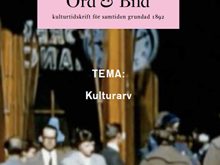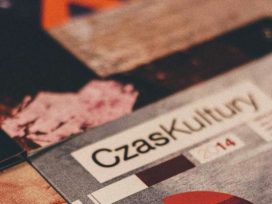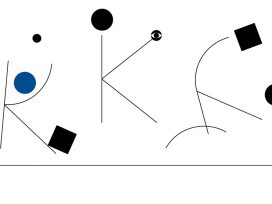As a writer and curator working in the rarefied, dematerialized realm of contemporary art, I don’t get to dirty my hands very often – and I don’t necessarily think that’s a bad thing: I’ve “chosen” this line of work (if one can ever really choose such a thing) precisely to avoid dirtying my hands – except perhaps with the odd symbolic blot of machine-washable ink, the stigmatic bloodstain of true “writing”. (Friedrich Nietzsche’s Zarathustra: “Of all that is written, I love only what a person hath written with his blood.”) Overseeing the install at the museum where I work, some four years ago, of a large-scale group show consisting primarily of film, video and lots of oversized framed photographs, I thought of helping the team of preparators carry the odd photograph around the museum spaces – only to be reprimanded by a curatorial colleague (“What do you think you’re doing? Put that photograph down!”), who immediately summoned the specter of potentially ruinous insurance claims should I, an intellectual laborer first and foremost, let something slip from my untrained hands. (By the way, even for intellectual labor my hands are grossly unqualified: I type with one finger only, two at the most.) Still – fast forward to the much more recent past – I was particularly happy to find myself stuck, on the eve of the opening of a big exhibition at the very same museum, kneeling on the floor of the workshop, stuffing thick bundles of straw inside the hollow cloth shells of seven mangy-looking scarecrows in-the-making: some twelve hours later (this was eleven o’clock at night), they would queue up to form “The Antwerp six or seven”, the site-specific artwork conceived by Daniel Knorr for a four-day open air sculpture exhibition on the vast square opposite the Antwerp museum of contemporary art MuHKA in September 2008. I mention the crude material facts of my manual contribution to the production of this work (the straw, the kneeling) because they are constitutive of the fundamental paradox (or, more directly, dialectic) that structures much of Daniel Knorr’s work to date, which could perhaps best be described as a “nuts-and-bolts-type conceptualism” – a conceptually inflicted practice of very immaterial ideas, often reflecting upon the notion of materialization and dematerialization as such, that habitually require very (and almost archaic) material realizations: his is an art predicated on the immediate experience of the irreducible materiality of all thought, on the crafty mining of those ideas that lie dormant (and require cautious, manual awakening) in matter, clutter, stuff. Witnessing at close hand (no pun intended!) how his work comes about – with “nuts and bolts”, using hammers, nails, screwdrivers and saws and other tools not immediately or often associated with the lofty trade in concepts – I now know the actual physicality of Knorr’s work, not a quality easily thought of when we consider the “ideas first” mirage of conceptual art as an exclusively intellectual, cerebral practice. Indeed, does Lawrence Weiner himself stick his letters on the wall? Does Joseph Kosuth himself mount his neon wall pieces? Does he even “know” the technology that animates their luminescence? One of the first times I met Daniel Knorr in Berlin, the artist was in the process of installing a colorful garland of sixty-odd flags hanging from the roof of Mies van der Rohe’s Neue Nationalgalerie for the 2008 Berlin Biennial: he was wearing blue overalls…
Now, on this sartorial note, to turn back to “The Antwerp six or seven”: I should of course mention that these scarecrows, numbering seven in total (a phalanx of six on the actual square in front of the museum, one lonely dropout perched on the museum’s rooftop), were not just wearing any old rags casually shopped together after an afternoon spent rummaging through the sales bins of Antwerp’s many vintage clothing outlets – they were dressed up in state-of-the-art, pricy Antwerp designer gear. Indeed, the title of the work referred to the fabled “Antwerp six,” a loose grouping of former fashion academy students (all graduates of the annus mirabilis 1986) that included Dirk Bikkembergs, Ann Demeulemeester, Walter Van Beirendonck, Dries Van Noten, Dirk Van Saene and Marina Yee, the designers responsible for launching the city’s unlikely status as a major fashion hub; the seventh scarecrow was clad head to toe in a Martin Margiela outfit – although a graduate of the same fashion department at the Antwerp art academy, Margiela has always kept a firm distance from the fashion establishment: one reason, perhaps, why his clothes are so singularly popular with the art crowd instead. This complex, elaborate project consisted of many layers – expounding on the participatory dimension of the work would warrant an essay of its own – but among its more engaging formal aspects was certainly the jarring contrast between the value accorded to these particular clothes on the one hand – a value both embodied by the “label” (a cipher of mere monetary or exchange value) as well as represented by their crafty design (i.e. actual use value) – and the artist’s appropriation of the abject folk figure of the scarecrow on the other hand. Scarecrows belong to a long, unwritten history of plebeian, utilitarian sculpture (as well as to the history of human figuration and its place in material culture more broadly), and Knorr’s incongruous quotation from this tradition, bracketed by the ennobling touch of high fashion, is wholly in character with the artist’s long-standing interest in an aesthetics of poverty and the critical potential of “poor things”, if not downright trash or street litter (as is the case in his well-known “Carte de Artiste” series of artist books, made in different cities around the world using waste picked up, with great, meticulous care, from their respective streets). Seeing Knorr’s phalanx of scarecrows rise above the crowd of visitors to the exhibition’s opening on September 11, 2008, a great many associations flooded and muddled the mind – what with their resembling crucifixes posted at the edge of the square, miserably failing in their assigned job of scaring people from the grounds? – but at the heart of it all is the work’s essential appearance as a sculpture, sewn together, so to speak, from the lowliest organic waste (bundles of straw, wood, “nature”) and the costliest hand-made artifacts (craft, “culture”).
It may seem parochial, reductionist or plainly “orientalist” to interpret Daniel Knorr’s occasional predeliction for crude or poor materials, as well as (much more importantly) for working from the conditional constraints of a factual “poverty” (or a similar condition of destitution, of lack), as somehow determined by his growing up in Romania in the seventies and eighties, a country then groaning under the spectacular misrule of the Ceaucescu government; after all, Knorr left his native Romania when he was only fourteen years old, and (a prolonged stay, in the second half of the nineties, in the United States aside) has lived in Germany for such a long time that he may just as well be called a German artist. However, some of his most emblematic works were produced within the definite, local context of Bucharest’s public space, and in 2005 Knorr was asked to represent his native Romania at the Venice Biennial – all the more reason, then, to read at least some (and rather crucial) aspects of his artistic practice as squarely located within (or otherwise related to) a certain geo-historical context, namely that of Central and Eastern European conceptual art of the late sixties and seventies, a context which was shaped in no small measure by the everyday urgency of making ends meet in an economic reality that was immeasurably different from that which spawned its Western European and American counterparts. This crudely “economic” difference may perhaps help to explain the quality of existential depth and acute sense of personal, bodily involvement in the process of art-making that was typical of much of the work done in this localized vein, from Marina Abramovic, Julius Koller and Jiri Kovanda, to Ivan Kozaric, Edward Krasynski and Mladen Stilinovic – one reason why the “rediscovery” of many of these practices has been the source of such great art-historical excitement in recent years (especially within the context of so-called “romantic conceptualism”): here was an art of ideas (“conceptualism”) that actually appeared anchored in a notion of experiential urgency that brought the artist back into the fold of the world, rather than merely steering him or her away from it, as was so often the case in the hieratic, self-important language games then prevalent in, say, New York conceptualism. This is probably also the reason why the paths of so many Central and Eastern European conceptual art practices from the seventies and eighties intersected much more often with what in the West was then called “body art,” which most of the Concept Art pioneers hailing from the established power centers, in their delusional quest for pure, uncluttered and ultimately disembodied concepts, visibly took great pains to distance themselves from: for the likes of Kovanda and Stilinovic in particular, the artist’s body was simply the only dependable tool and/or material at their disposal (hence the often overly dramatic nature of the work, so easily reconfigured as a latter-day variant of the Central European romantic tradition), their bodies often the sole site available for the materialization of certain concepts or “projects.” So here we once again come across the laboring body – not an image we are inclined to invoke when pondering the “work” of, say, Robert Barry.
Not the laboring body, but rather the artist’s body in a state of quasi-Oblomovian torpor, finally, is at the center of another work (or series of works) by Daniel Knorr, titled “Awake/Asleep.” Essentially a performance piece that connects a certain light source (or the lighting of a given architectural entity) to the sleeping and waking rhythm of the artist, this work exists by virtue of a mechanical device or contractual agreement which allows Knorr to switch off the lights of (or on) a given site every time he goes to bed, and switch them back on again every time he wakes up, irrespective of the geographical distance that separates him from the light source. In the exhibition at the Kunsthalle Basel, this work is scaled down to its barest minimum, pure economic conceptualism: a single reddish LED light sunk in one of the walls of the exhibition space is either turned on or off, depending on the artist’s state at the moment of observation – this in stark contrast to the monumental scale on which the work was produced, earlier this year, in Warsaw, where the implementation of “Awake/Asleep” effectively implied shutting down the gigantic lighting system of one the city’s biggest landmark buildings, the Soviet-era Palace of Culture and Science, as Stalin’s hated and much-maligned “gift” to the people of Poland is officially known. Using only a mobile phone as a remote control (one single message sufficing to order the illumination of the skyscraper whenever he wakes up, whether in his home in Berlin or on the road in New Zealand), Knorr basically reduced the Palace of Culture to a faintly neo-gothic bedside lamp – a gesture and an image literalized by two pictures of the artist gracing the homepage of the Warsaw Museum of Modern Art, the institution that commissioned this most spectacular incarnation of the work to date: one shows him lying down eyes open still, the other one assuming the same position, eyes closed, presumably asleep. The political dimension of this particular variation upon an already existing work hardly requires further explication (and does continue the heterodox, critical tradition of the “body and/in the east” referred to above), but the crux of this installment of “Awake/Asleep” may well lie in these unassuming photographs of the artist assuming a horizontal position: they invoke memories of Oblomov, to be sure, that magnificent cult hero of the Slavic cultural imagination, but they also reference the work of a representative of a very different cultural sensibility – Andy Warhol’s Sleep. And not only Sleep, for that matter (that’s five hours of John Giorno, sleeping), but also Empire, Warhol’s real-time marathon film of New York’s Empire State Building at night – the architectural monument of mid-century modernism after which many Stalinist skyscrapers such as the Palace of Culture and Science were so obviously modeled. These associations and allusions certainly help – if help is what we want – to rephrase our experience of Daniel Knorr’s work as resulting from a practice that is essentially rooted in an idea of private, some would perhaps say existential, urgency: an art wholly woven into the bodily fabric of everyday life, of a relentless and vital physicality. After all, we all have to sleep some time – and both Daniel Knorr (I think) and myself (I know) take our art with us to bed.






